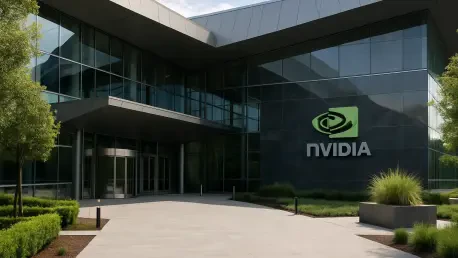As the artificial intelligence revolution continues to reshape industries, one technology giant stands at the forefront, often celebrated for its powerful AI processors, yet a quieter segment of its portfolio is driving significant advancements in the background. Nvidia Corporation, a titan in the tech world, is not just about cutting-edge chips; its networking business within the Data Center segment is emerging as a critical enabler of AI infrastructure. While much of the spotlight shines on processor sales as earnings reports loom, such as the upcoming second-quarter results expected on August 27, a deeper look reveals how networking solutions are pivotal to connecting and scaling AI systems. This often-overlooked division, encompassing technologies that facilitate communication between chips, servers, and users, is becoming a cornerstone of modern data centers. The growing importance of these solutions highlights a nuanced balance in Nvidia’s strategy, where networking plays an indispensable role in supporting the AI boom.
Unveiling the Backbone of AI Infrastructure
The Critical Role of Networking Technologies
In the complex ecosystem of AI-driven data centers, Nvidia’s networking technologies serve as the vital arteries that ensure seamless communication across systems. Solutions like NVLink, InfiniBand, and Ethernet are not just supplementary; they are fundamental to building high-performance AI supercomputers. NVLink enhances GPU connectivity within servers, boosting computational efficiency, while InfiniBand links multiple server nodes to form expansive AI computing networks across data centers. Ethernet, on the other hand, manages front-end storage and system operations, ensuring smooth integration. As Nvidia’s senior vice president of networking, Gilad Shainer, has emphasized, the ability to connect computing engines into a unified, larger system is paramount for supercomputer development. This intricate web of connectivity underscores how networking is not merely a support function but a linchpin in enabling the scalability and speed required for cutting-edge AI applications, distinguishing Nvidia in a competitive landscape.
Enabling Scalability for Diverse Applications
Beyond the technical intricacies, Nvidia’s networking solutions are tailored to meet the demands of a wide array of customers, from research universities to sprawling hyperscale data centers. These technologies empower organizations to expand their AI capabilities, accommodating everything from small-scale experiments to massive, enterprise-level deployments. Kevin Deierling, another senior vice president at Nvidia, has noted that all three networking types—NVLink, InfiniBand, and Ethernet—are essential for constructing AI systems at varying scales. This adaptability ensures that whether a client is processing complex machine learning models or managing vast data storage needs, Nvidia’s infrastructure can handle the load efficiently. The significance of this flexibility cannot be overstated, as it positions the company to support the accelerating adoption of AI across industries, ensuring that its networking business remains a key driver of growth in an era where data and connectivity are paramount.
Financial Impact and Future Potential
A Surge in Networking Revenue
The financial performance of Nvidia’s networking business paints a compelling picture of its rising prominence within the Data Center segment. In the most recent fiscal data, networking sales contributed a substantial $12.9 billion to the segment’s staggering $115.1 billion total revenue, outpacing even the $11.3 billion generated by the Gaming division, Nvidia’s second-largest segment. More recently, in the first quarter, networking accounted for $4.9 billion of the $39.1 billion in Data Center revenue, representing roughly 11% of the company’s total earnings. While this percentage might seem modest at first glance, the rapid growth trajectory—described by industry analyst Gene Munster as expanding “like a rocket ship”—signals a robust future. These figures highlight how networking, though often overshadowed by AI chip sales, is carving out a significant and expanding niche, reflecting the increasing reliance on interconnected systems to power the next generation of technological innovation.
Looking Ahead to Sustained Expansion
As AI adoption continues to surge, the networking segment of Nvidia’s portfolio is poised for sustained growth, driven by the escalating needs of data-intensive environments. Customers across various sectors are investing heavily in infrastructure to support AI workloads, creating a fertile ground for networking revenue to flourish. Industry analysts and company executives alike view this segment as a foundational element of AI infrastructure, deserving greater recognition for its contributions to both technological progress and financial outcomes. The ongoing expansion of data centers and the push for more powerful computing systems suggest that demand for Nvidia’s networking solutions will only intensify in the coming years. Reflecting on past achievements, the remarkable ascent of this division over recent quarters demonstrates a clear trend of outperformance, setting a precedent for future success and cementing its role as a vital component in the broader narrative of AI-driven transformation.









